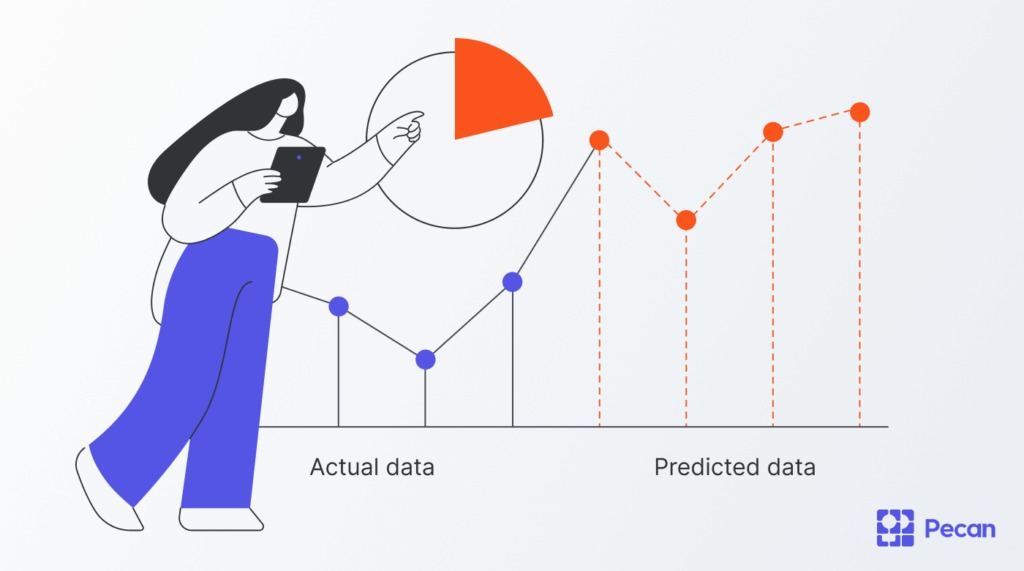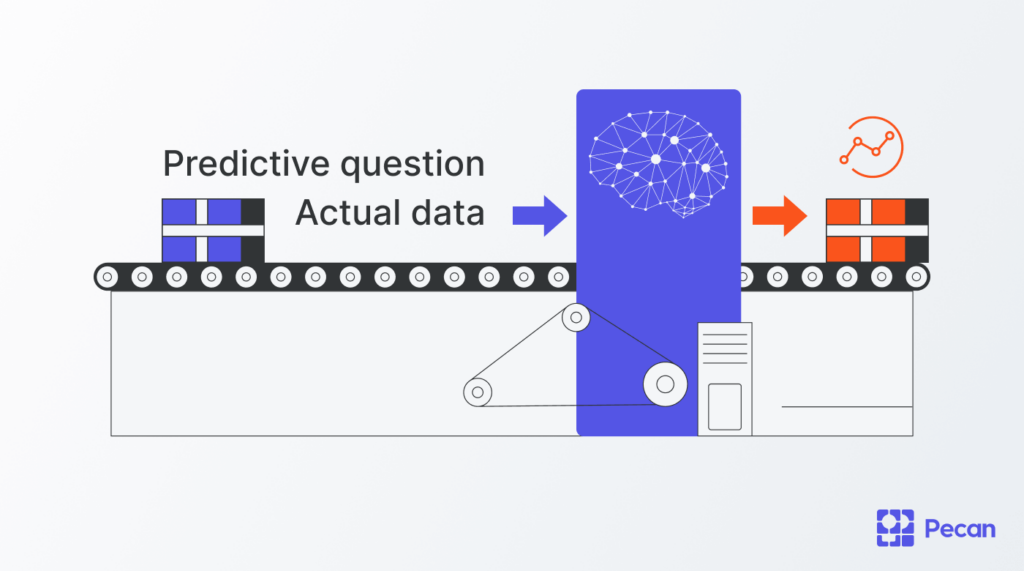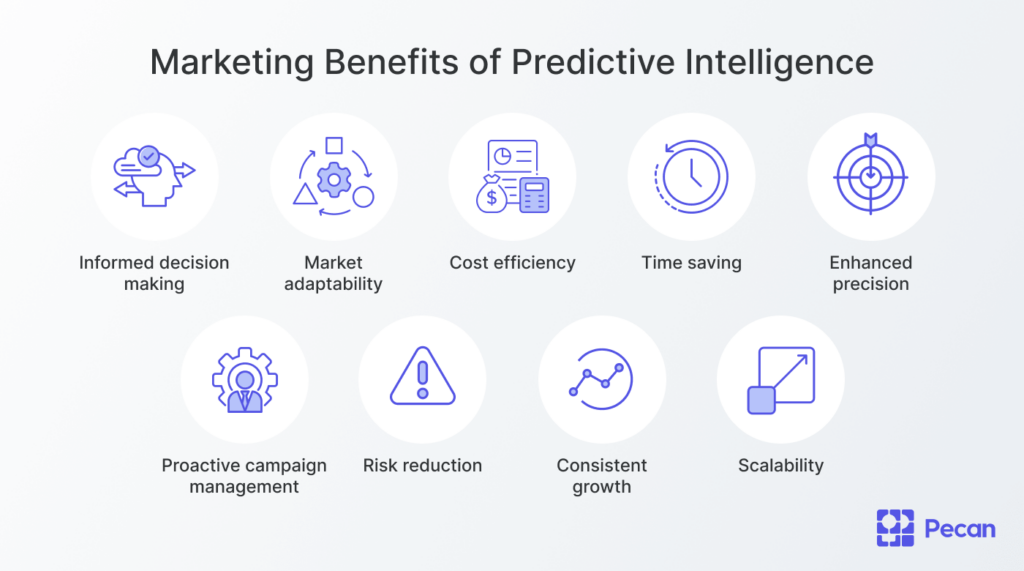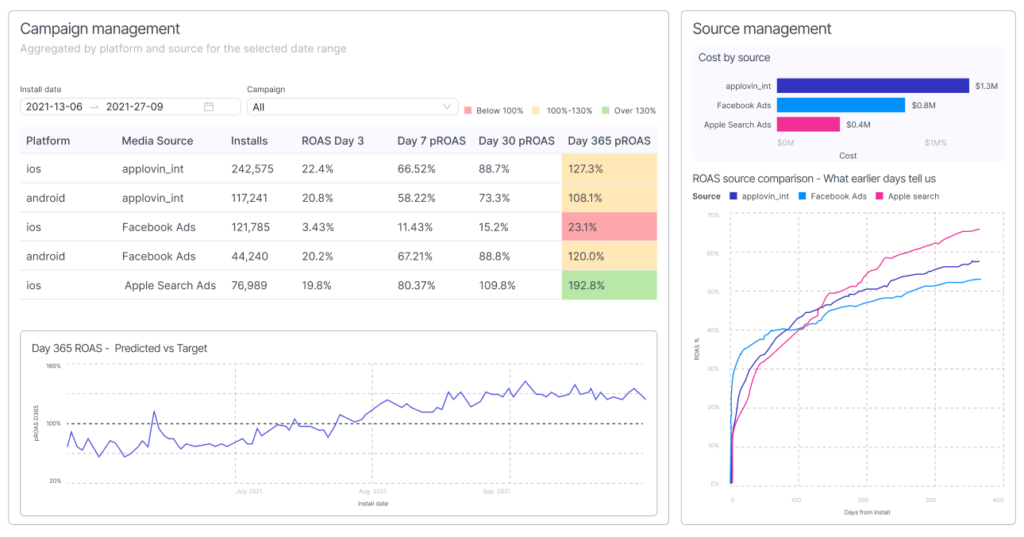In a nutshell:
- Predictive intelligence (PI) uses data and algorithms to forecast future events like customer behavior and product demand.
- PI differs from traditional forecasting by leveraging machine learning for dynamic adaptability and automated data processing.
- PI benefits businesses by enabling informed decision-making, adapting to market changes, and reducing costs.
- Examples of using PI include tailored content recommendations, optimizing ad spend, and enhancing customer experiences.
- Pecan AI simplifies predictive modeling with a user-friendly platform that accelerates insights and adjustments for prompt decision-making.
Most future-forward businesses understand the value of predictive models that help anticipate future trends and customer behavior. However, 40% say the high cost of manual data science is the number one blocker to harnessing predictive analytics.
Thanks to the advancement of artificial intelligence (AI), there’s no longer a need for costly manual data preparation and modeling. Predictive intelligence tools can supercharge growth strategies with even the most disorganized data.
Read on to learn what predictive intelligence is and how it can pioneer growth in your business.
What’s predictive intelligence?
Predictive intelligence (PI) harnesses data and algorithms to accurately forecast upcoming events, such as product demand, customer preferences, and potential sales.
Powered by artificial intelligence and machine learning, it deeply analyzes historical patterns and uses them to model informed, forward-looking strategies.
PI is highly adaptable. It learns to improve its modeling over time, getting better with richer data.
But how does it differ from traditional approaches?
Conventional forecasting methods required human intervention and often relied on simplistic linear projections. PI harnesses machine learning, allowing for dynamic adaptability. Data processing and feature selection are automated, improving accuracy and speeding up forecasts.
Businesses previously relied on rudimentary manual forecasting tactics. Now, 69% of corporate strategists have either deployed or piloted predictive analytics systems. Using complex algorithms, these systems are capable of predicting intricate nuances in market trends and customer behavior. They can match and overlay data to provide more accurate, sophisticated predictions that manual forecasting can't.
This transformative journey enables data analysts to anticipate market shifts with unmatched precision. This makes it easier to personalize customer experiences and meet buyer needs innovatively.
This improves products and services and reduces the costs of wasted campaigns.
How does predictive intelligence work?
Predictive intelligence enables strategists to devise innovative solutions to scale and evolve. Here’s how.
Fostering a predictive mindset
By harnessing the power of PI, you’re no longer digging into unpredictable or unrelated data avenues.
Instead, you can predict how trends and patterns will evolve. Analysts aren't simply identifying past patterns but are questioning future possibilities. This lays the groundwork for visionary business strategies. This kind of forward-thinking sparks a predictive mindset.
The power of predictive questions
PI works using predictive questions. Consider it setting a compass to help guide the model’s direction.
When crafted well, questions clarify the desired outcome. This leads to more accurate and actionable predictions.
For example, a data analyst may ask, "Which customers are most likely to churn in the next quarter?" This is an effective predictive question because it’s specific and time-bound. In contrast, "What will happen to our customers?" is nebulous. It lacks precision, leading to a spiral of unrelated and unusable projections.
Data integration: The machine’s fuel
In the PI universe, data is the lifeblood that AI models tap into for accurate predictions. Combining diverse data sources gives the predictive model a more holistic perspective. This gives it the power to pinpoint concealed or less obvious patterns.
For instance, marketers can integrate data like website activity and social media engagement. PI will conclude personalized marketing strategies that align with future demand.
Automatic model creation: Elegant efficiency
Using advanced machine learning algorithms, the integrated data undergoes rigorous analysis.
The platform autonomously chooses and refines “features.” These are the individual, measurable properties or characteristics of the data, which are also often called variables. For example, customer experience features might include first response times and ticket volume.
As the model is fed more data and business practices reflect the new predictive approach, it should be adjusted—ideally automatically—to ensure that predictions remain sharp and relevant.
In short, you benefit from precise, automated predictions without the cost and effort of manual model building.
How predictive intelligence can benefit growing businesses
Scaling your business means evolving with customer trends, expectations, and behaviors. Predictive intelligence can help you identify these changes and strategize to meet future market demand.
Informed decision-making: PI leverages diverse data to highlight patterns that help you make sensible strategic choices. For example, a marketer might use it to analyze past campaign performance data to optimize future content strategies.
Adapting to market changes: PI enables an agile response to evolving market dynamics. For instance, your PI platform may notice a surge in sales of a particular product category. This enables you to capitalize on this trend quickly. You might add similar products to your range that reflect new preferences.
Cost efficiency: PI helps you optimize resources by focusing on high-yield opportunities. For example, an inventory manager can streamline purchasing by predicting seasonal high-selling items. That way, they don’t waste purchasing budgets on unpopular products.
Time-saving: Automated data analysis speeds up business decision-making. Imagine a supply chain manager who can auto-evaluate supply chain efficiency. They can quickly adjust to supplier delays or disruptions to prevent reputational damage from late orders.
Enhanced precision: PI provides precise business projections to reduce uncertainty in planning. Picture a product launch professional planning a service rollout. They can tailor regional launch strategies based on accurate local demand forecasts.
Risk reduction: Predictive analysis can identify potential challenges in business plans. For example, your PI model may predict a decrease in market demand for a certain service. That way, you can pivot away from incorrect investments before it’s too late.
Scalability: PI models adapt to growing data demands. They improve with the input of more diverse data. As your business scales, models adapt their predictions. Picture a successful local store looking to open multiple locations nationwide. Its PI models can pinpoint the most promising locations or suggest the right timings to launch new stores.
How to use predictive intelligence to evolve with market demands: Examples
Predictive intelligence gives you an eye into the future. It allows you to predict upcoming trends and devise innovative strategies to stay ahead of competitors. Here are a few actionable ways to leverage predictive intelligence to stay relevant.
Generate tailored content recommendations
Use PI to guide content decisions. Understanding customer preferences allows you to tailor your marketing efforts to meet expectations.
Imagine you’re a digital marketing manager creating content across five different channels. Your predictive intelligence platform highlights two main channels of engagement. Now, you can focus your time, energy, and budget on content for these channels instead of spreading yourself too thin. Additionally, generative AI tools can complement your predictive AI to make this content even more highly effective and personalized.
Optimize ad spend
PI helps you determine where the highest returns are so you can allocate your budget more efficiently and meet strategic goals at a lower cost.
For instance, a sales manager may find that most qualified leads come from webinar sign-ups instead of social advertising. They can now roll back social ads and steer funds toward creating more webinars.
Segment customers effectively
44% of businesses harness predictive analytics for customer segmentation. PI can categorize potential customers based on their similarities to past buyer behavior. This makes it easier to create user experiences that match the preferences of each customer segment.
For example, one customer segment may respond better to SMS customer service communication. Another prefers email contact. PI can categorize these customers so you can tailor their user experiences.
Improve demand forecasting
With PI's ability to gauge sales trends, businesses can get a complete picture of how to adapt to meet evolving market demands.
For instance, a product buyer may use PI modeling to predict demand for a product line in the next quarter. They can purchase relevant products and drop product lines that aren’t likely to convert.
Enhance customer experience
Growing businesses need to provide a seamless customer journey. Currently, 51% of marketing teams use PI to make customer-level predictions about future behavior. They can then leverage PI to personalize experiences to meet customer expectations based on their behavior.
For example, an online retailer might use PI to analyze website heat-map data, cart abandonment rates, and click rates. The retailer improves website navigation to encourage conversions.
Identify market opportunities
Staying ahead requires spotting gaps in the market and filling them. Half of businesses employ predictive intelligence to identify upcoming market trends. This is because predictive intelligence offers a lens into potential market needs. It analyzes historical data to predict how these trends may evolve.
For instance, PI can help you determine new target demographics that hold potential for sales based on predicted spikes in demand.
Reduce churn rates
Growing businesses can't afford to lose customers. PI highlights those at-risk customers and provides suggestions on effective retention strategies.
For example, PI would segment customers who are vulnerable to churn. It might suggest loyalty programs for some customers and promotions for others.
The Pecan AI advantage
Pecan AI simplifies the predictive model-building process thanks to its user-friendly no-code platform.
It’ll automatically clean, standardize, and enrich even messy data to accelerate predictive modeling without manual data cleansing.
You can easily tailor its adjustable predictive queries to specific business objectives to ensure relevant, customer-centric forecasts.
Pecan AI’s predictive models are easily digestible. You get insights about what will happen in the future (and why) without the hassle of deciphering complex datasets. You can integrate these suggestions effortlessly for prompt internal decision-making.
Pecan AI’s models are operational within days, not months, unlike traditional analytics suites or manual data science projects.
Not only is it super adaptable, it's easy to make model adjustments. Predictions regularly update automatically to ensure your forecasts remain current and relevant.
Stay ahead of the curve with predictive intelligence
With PI tools, you can see what your customers want and cater to their needs without hours and hours of manual modeling.
Pecan AI is the ideal predictive intelligence tool because it simplifies predictive modeling. Our easy-to-build automated system does not require coding skills.
To upgrade your growth strategies and meet customer expectations better, sign up for Pecan AI for free.










